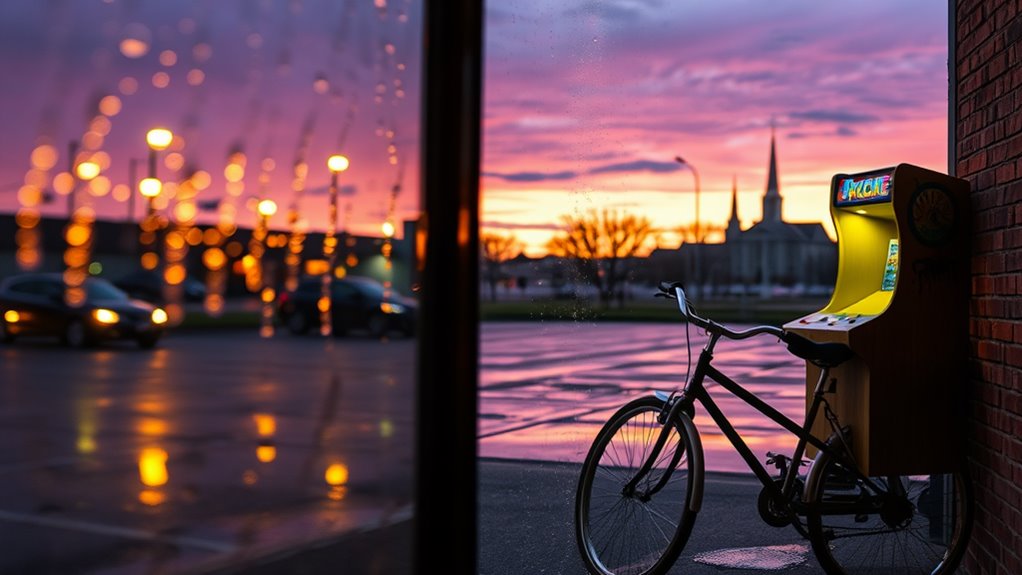Arcade Fire emerged from Montreal’s indie rock scene in the early 2000s, with their debut album “Funeral” (2004) establishing them as one of the most influential bands of their generation. “Wake Up,” a standout track from this album, blends orchestral arrangements with post-rock intensity, helping define the era’s indie rock sound. The song received widespread critical acclaim and has become an arena-filling anthem, covered by numerous artists and featured in various media. This analysis explores the song’s central theme of lost innocence and the jarring transition from childhood idealism to adult disillusionment. How does a song about personal awakening become a collective experience of catharsis?
At a Glance
- The song explores the painful transition from childhood innocence to adult awareness, using a wake-up call as both literal and metaphorical symbolism.
- Weather imagery throughout the lyrics represents emotional turbulence and the stormy process of losing childhood innocence.
- The narrative addresses the gap between youthful dreams and adult realities while advocating for preserving elements of childlike wonder.
- Themes of collective consciousness and shared experience emerge through communal vocals and anthemic chorus structures.
- The lyrics balance grief and hope, transforming personal disillusionment into a message of spiritual and social awakening.
Final Track, Funeral Album

Thematically, “Wake Up” serves as a pivotal moment of collective consciousness, with its soaring chorus and communal vocals establishing a sense of shared grief and resilience.
This contrasts intentionally with the later personal narrative of “In the Backseat,” showing how the album moves from universal experiences to individual processing of loss.
The song’s production employs analog recording techniques that characterize Funeral’s raw emotional sound, with layered instruments and vocals creating a wall of sound that exemplifies the album’s orchestral ambitions.
This sonic approach influenced subsequent indie rock productions and established Arcade Fire’s signature style.
Within the album’s narrative arc, “Wake Up” functions as a call to action, addressing themes of disillusionment and the need for spiritual awakening. The song emerged during a period when many of the band members experienced family deaths, which deeply influenced the album’s thematic content.
Its placement after the “Neighborhood” sequence but before the album’s conclusion allows listeners to shift from specific stories of community struggle to broader existential questioning.
The track’s influence extends beyond Funeral, establishing musical and thematic elements that would become hallmarks of Arcade Fire’s subsequent works, particularly in albums like Neon Bible and The Suburbs.
Its positioning demonstrates how the band carefully constructed album narratives that balance collective experience with personal reflection.
Musical motifs introduced in “Wake Up” find resolution in later tracks, particularly in the crescendos and instrumental swells that reach their ultimate expression in “In the Backseat.”
Fans can track their listening experience of the album through Last.fm scrobbling, allowing them to document their engagement with the record’s emotional journey.
This careful sequencing reinforces Funeral’s reputation as a cohesive artistic statement rather than merely a collection of songs.
Children Losing Innocence Theme
The song’s core message centers on the inevitable alteration from childhood innocence to adult awareness, depicted through vivid imagery of summer fading to dust. This shift serves as both a warning and a lament, highlighting how growing bodies parallel shrinking emotional capacities and increasing disillusionment.
Weather imagery throughout the song reinforces the turbulent nature of losing innocence. Lightning bolts illuminate harsh truths, while storms represent the chaos of emotional development. These natural phenomena mirror the internal struggles of youth confronting reality’s complexities for the first time. The song’s use in Where The Wild Things Are further emphasized these themes of childhood transformation. Folk-inspired instrumentation adds layers of nostalgic depth to these weather metaphors.
The recurring wake-up motif functions on multiple levels, serving as both a literal call to children and a metaphorical awakening to life’s harder truths. This awakening carries dual meanings of loss and necessity, suggesting that while innocence must fade, awareness shouldn’t lead to emotional numbness.
Materialistic and technological aspects of modern society emerge as corrupting forces in the narrative. The song points to inherited societal problems that accelerate the loss of childhood wonder, creating a cycle of disconnection that spans generations. The mention of multiple gods causing destruction speaks to humanity’s role in perpetuating this damage.
The emotional journey progresses from recognition to resistance, suggesting that acknowledging the loss of innocence is essential for preserving some essence of childhood wonder. The song’s structure mirrors this progression, moving from somber reflection to communal catharsis, offering hope that collective awareness might break cycles of emotional deterioration.
Physical growth contrasted with emotional decay emerges as a central paradox, illustrated through imagery of expanding bodies and deteriorating hearts. This juxtaposition emphasizes how maturation often comes at the cost of emotional vulnerability and genuine connection.
Crescendoing Guitar and Drums

The gradual instrumental build in “Wake Up” serves as a masterful example of musical storytelling through arrangement. Starting with delicate arpeggiated guitar chords in C major, the song establishes an introspective foundation before methodically adding layers of instrumentation.
The initial sparse drumming provides a steady heartbeat, using simple patterns that allow the guitar work to shine through. As the arrangement progresses, the percussion becomes increasingly complex, incorporating floor tom patterns and strategic snare rolls that drive the song’s momentum forward. The song’s chord-melody tension metrics contribute significantly to its emotional depth.
Guitar textures evolve throughout the piece, shifting from clean, melodic passages to distortion-heavy power chords. The layering of rhythm and lead guitar parts creates a rich sonic tapestry, with interweaving melodies that support the growing emotional intensity of the lyrics. Early performances of the song saw half the audience leave due to this dramatic shift in style.
The song’s dynamic range is particularly notable in how it mirrors the thematic journey. Soft verses give way to increasingly powerful choruses, while the instrumental density grows progressively thicker. This buildup culminates in the anthem-like “whoa-oh” section, where the full band reaches its peak intensity.
The rhythm section locks together during the crescendo, with drums and guitar working in precise synchronization to create a solid foundation for the vocal swell. Strategic use of percussive accents emphasizes key lyrical phrases, adding impact to emotional high points.
The arrangement’s careful construction transforms intimate moments into grand, communal expressions. Each instrumental element contributes to the mounting tension, creating a signature sound that has become iconic in live performances.
The crescendo structure ultimately serves both the song’s narrative arc and its ability to connect with audiences on a visceral level. This architectural approach to arrangement helps convey the song’s themes of awakening and change, making the musical journey inseparable from its lyrical message.
The result is a powerful synthesis of sound and meaning that has become a defining characteristic of Arcade Fire’s musical identity.
David Bowie Praised Song’s Impact
David Bowie’s endorsement of “Wake Up” marked a pivotal moment in the song’s reception, transforming it from an indie rock anthem to a widely recognized masterpiece. Music critics particularly noted how Bowie’s involvement highlighted the song’s ambitious scope and grandiose arrangements, drawing parallels to his own theatrical rock productions of the 1970s. His haunting vocal presence added an ethereal dimension to the song’s impact.
The collaborative performance at Fashion Rocks in 2005 garnered widespread media attention, with reviewers praising the natural chemistry between Bowie and Win Butler’s vocals. Following what had been months of discussions, the intergenerational duet demonstrated the song’s universal appeal, bridging the gap between classic and contemporary alternative rock audiences.
Music publications consistently ranked “Wake Up” among the defining songs of the 2000s indie rock movement. The track’s emotional crescendos and communal chorus gained additional gravitas through Bowie’s association, with critics often citing it as a prime example of how modern bands could successfully channel the art-rock ambitions of previous generations.
Online fan communities have extensively documented the song’s evolution from its album version to its various live interpretations, with the Bowie collaboration remaining a particularly celebrated rendition. Fan forums frequently discuss how the performance enhanced the song’s themes of spiritual awakening and social consciousness, adding new layers of meaning to the original recording.
The song’s cultural impact extended beyond music circles, finding its way into film soundtracks, sporting events, and political rallies. This broader cultural adoption, combined with Bowie’s seal of approval, helped cement “Wake Up” as a modern rock standard that continues to resonate with new audiences and garner critical acclaim years after its initial release.
Dreamlike Nostalgia Hits Hard

“Wake Up” resonates deeply because it captures that universal moment when we first recognize the gap between childhood dreams and adult realities. The song’s genius lies in how it transforms this potentially depressing realization into a catalyst for collective healing and connection.
The dreamlike musical atmosphere, particularly in C Major with its layered harmonies, creates a space where listeners can safely confront their own lost innocence. Rather than wallowing in melancholy, the anthemic structure invites a shared catharsis – allowing audiences to acknowledge their disillusionment while simultaneously reclaiming some of that childlike wonder through communal experience. At one particular wedding outside Philadelphia, the song created a spontaneous dance party where guests moved freely without direction.
What makes the song particularly powerful is its philosophical duality: it acknowledges life’s inherent pain and loss while suggesting that this very awareness can lead to a deeper kind of freedom. The musical journey from introspective verses to soaring chorus mirrors the emotional arc of processing grief and finding connection through shared human experience.
This masterful balance between nostalgia and forward momentum helps explain why the song has become such a powerful concert experience. In live settings, it transforms individual reflection into collective affirmation, as if the audience is collectively deciding that while we can’t return to childhood innocence, we can create new meaning through shared vulnerability and celebration.
The composition’s emotional complexity serves as a reminder that growth requires both embracing and letting go – a theme that speaks to anyone traversing the bittersweet territory between youthful dreams and adult wisdom.


Leave a Reply